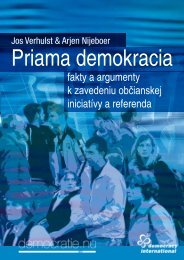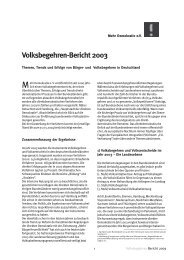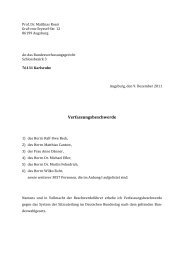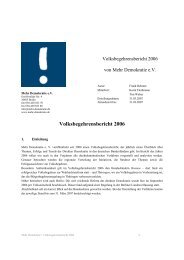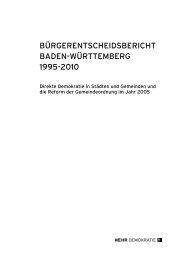Facts and Arguments about the Introduction of Initiative and ...
Facts and Arguments about the Introduction of Initiative and ...
Facts and Arguments about the Introduction of Initiative and ...
You also want an ePaper? Increase the reach of your titles
YUMPU automatically turns print PDFs into web optimized ePapers that Google loves.
5-1: The art <strong>of</strong> <strong>the</strong> citizens’ initiative<br />
Below is a checklist <strong>of</strong> some basic rules that must be taken<br />
into account when launching a citizens’ initiative. The most<br />
important sources are: Jim Shultz, ‘The <strong>Initiative</strong> Cookbook’,<br />
<strong>and</strong> Michael Seipel & Thomas Maier, ‘Triumph der<br />
Bürger!’ (The Citizens’ Triumph!).<br />
General rules<br />
• Usually, <strong>the</strong> side that convinces <strong>the</strong> undecided or floating<br />
voters wins.<br />
• The strongest force behind <strong>the</strong> politics <strong>of</strong> <strong>the</strong> referendum is<br />
public discontent. One should carefully establish whe<strong>the</strong>r<br />
<strong>the</strong>re is discontent <strong>and</strong> whe<strong>the</strong>r this can be mobilised.<br />
• Referendum initiatives usually have majority public backing<br />
to begin with. This tends to drop <strong>of</strong>f during <strong>the</strong> campaign<br />
under pressure from <strong>the</strong> opponents. A slide from a<br />
70% to a 51% support position can happen quite easily; a<br />
move in <strong>the</strong> reverse direction is far harder.<br />
• Referendums are lost on <strong>the</strong> weakest point in <strong>the</strong> proposal.<br />
If <strong>the</strong> proposal has a weak point somewhere, <strong>the</strong> opponents<br />
will focus on that <strong>and</strong> exaggerate <strong>the</strong> weakness.<br />
Voters have very little inclination to vote for a proposal<br />
that has an obvious weak point, even when <strong>the</strong> main body<br />
<strong>of</strong> <strong>the</strong> proposal is sound.<br />
• Polarisation is inevitable. The voters must clearly see who<br />
is for <strong>and</strong> against <strong>the</strong> proposal <strong>and</strong> why.<br />
• Being able to show that ones opponents have a financial<br />
interest in <strong>the</strong> outcome is an extraordinarily effective way<br />
<strong>of</strong> winning support.<br />
Questions at <strong>the</strong> outset<br />
• Is <strong>the</strong>re sufficient public support? Opinion polls can be used,<br />
but remember that public opinion is fickle <strong>and</strong> can change.<br />
• Is <strong>the</strong>re a simple, winning message? Compare <strong>the</strong> opponents’<br />
possible message or key slogan with your own.<br />
• How strong is <strong>the</strong> support base? Are <strong>the</strong>re enough organisations<br />
that can step into <strong>the</strong> spotlight? Are <strong>the</strong> organisations<br />
that <strong>the</strong> public would naturally expect to support <strong>the</strong><br />
initiative also actually in favour <strong>of</strong> it?<br />
• Is <strong>the</strong>re any money? Fundraising must start early. The<br />
funding must be clear <strong>and</strong> underst<strong>and</strong>able. It must also<br />
be realistic <strong>and</strong> <strong>the</strong> accounts must always be up to date<br />
<strong>and</strong> readily available (e.g. for <strong>the</strong> media).<br />
• Is <strong>the</strong>re expertise readily available? Ensure that <strong>the</strong>re are<br />
enough people capable <strong>of</strong> dealing with technical problems<br />
or political disturbances during debates <strong>and</strong> speeches.<br />
• Is it possible to take advantage <strong>of</strong> any general or local elections?<br />
Holding <strong>the</strong> referendum at <strong>the</strong> same time as elections<br />
can help to increase turnout – important if <strong>the</strong>re are<br />
turnout quorums.<br />
Phrasing <strong>the</strong> question<br />
• The initiative/referendum proposal must be clear <strong>and</strong><br />
precise. The wording must be unambiguous <strong>and</strong> <strong>the</strong> proposal<br />
must be made public as early as possible.<br />
• The proposal must be drawn up with all <strong>the</strong> potential<br />
allies in mind. Do not include irrelevant aspects that<br />
might frighten <strong>of</strong>f possible allies. The opposite is also<br />
possible: ‘fence sitters’ (organisations that tend to adopt<br />
a neutral position) can take part in <strong>the</strong> coalition if certain<br />
aspects that are important to <strong>the</strong>m are included.<br />
3<br />
• The proposal must be drawn up with <strong>the</strong> public in mind.<br />
Does <strong>the</strong> proposal have a broad appeal? Does it have an<br />
Achilles heel?<br />
• Will <strong>the</strong> authorities accept <strong>the</strong> referendum result as binding?<br />
If not, <strong>the</strong>n tying political parties to it can be an option:<br />
get <strong>the</strong>m to promise to accept <strong>the</strong> result well before<br />
<strong>the</strong> referendum.<br />
• If <strong>the</strong>re is a victory in <strong>the</strong> referendum, can <strong>the</strong> result be<br />
contested in <strong>the</strong> courts? (Obtain legal advice)<br />
Coalition<br />
• A coalition which includes unusual allies streng<strong>the</strong>ns <strong>the</strong><br />
credibility <strong>of</strong> <strong>the</strong> initiative (e.g. ‘conservative’ <strong>and</strong> ‘progressive’<br />
political parties, employers <strong>and</strong> employees, etc.)<br />
• The core partners <strong>of</strong> <strong>the</strong> coalition must be available from<br />
<strong>the</strong> start.<br />
• Good agreements between coalition partners <strong>about</strong> funding,<br />
a common public position, <strong>the</strong> division <strong>of</strong> duties <strong>and</strong><br />
<strong>the</strong> appointment <strong>of</strong> spokesmen <strong>and</strong> -women are essential.<br />
Signature collection<br />
• Shultz writes: “The Zen <strong>of</strong> signature ga<strong>the</strong>ring is, don’t<br />
argue with anyone.” Signature collection <strong>and</strong> campaigning<br />
are <strong>the</strong>refore best done separately. Being tempted into<br />
a discussion lasting a quarter <strong>of</strong> an hour or more with one<br />
or more passers-by is not an efficient use <strong>of</strong> time during<br />
a signature ga<strong>the</strong>ring campaign. You have to try to maximize<br />
productivity when collecting signatures.<br />
• Make <strong>the</strong> link to <strong>the</strong> next step in <strong>the</strong> campaign. Signature<br />
collection enables <strong>the</strong> volunteers to build up some reserves<br />
<strong>of</strong> effort <strong>and</strong> commitment. If <strong>the</strong>se reserves are neglected<br />
when <strong>the</strong> signature threshold has been achieved,<br />
it makes it more difficult to remobilise <strong>the</strong> real campaign<br />
some months later.<br />
• Monitor <strong>the</strong> validity <strong>of</strong> <strong>the</strong> signatures. Signatures can be<br />
obtained from people with <strong>the</strong> wrong place <strong>of</strong> residence or<br />
nationality, or names <strong>and</strong> addresses can be unreadable or<br />
wrong. You should take an invalidity rate <strong>of</strong> 10% to 20%<br />
into account.<br />
• Arrange a media event for <strong>the</strong> submission <strong>of</strong> <strong>the</strong> signatures.<br />
The campaign<br />
• “Keep it simple <strong>and</strong> repeat <strong>the</strong> central message over <strong>and</strong><br />
over again.”<br />
• Also appeal to people’s emotions. Someone who appears<br />
both expertly <strong>and</strong> emotionally committed comes across<br />
well.<br />
• Retain a strong hold on <strong>the</strong> initiative during debates. Anyone<br />
who gets pinned down by <strong>the</strong>ir opponent on a sidetrack<br />
has lost. Beware <strong>of</strong> sneak attacks, particularly on <strong>the</strong><br />
campaign’s integrity.<br />
• In particular, established parties with power almost always<br />
play on public uncertainty <strong>and</strong> fears <strong>and</strong> drag up<br />
unrelated issues. You have to consciously anticipate this.<br />
References to foreign precedents in connection with <strong>the</strong><br />
proposal can be effective in disarming fear scenarios.<br />
• Parties in power will also address <strong>the</strong> public as individuals<br />
(‘Your social security’ instead <strong>of</strong> ‘Our ...’) <strong>and</strong> link this<br />
to an appeal for confidence in ‘solid values’, meaning <strong>the</strong><br />
parties in power <strong>and</strong> <strong>the</strong>ir leaders. Remedy: address <strong>the</strong><br />
public as a group <strong>of</strong> responsible people seeking common<br />
ground with each o<strong>the</strong>r.











